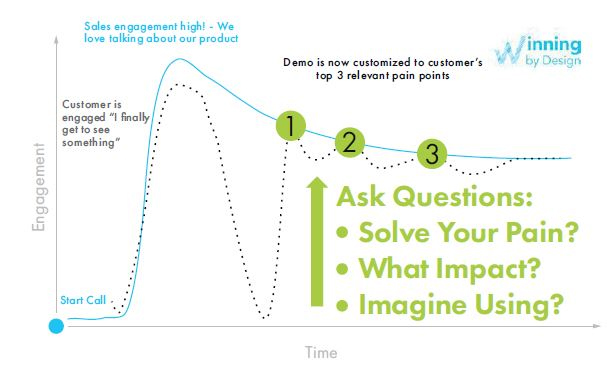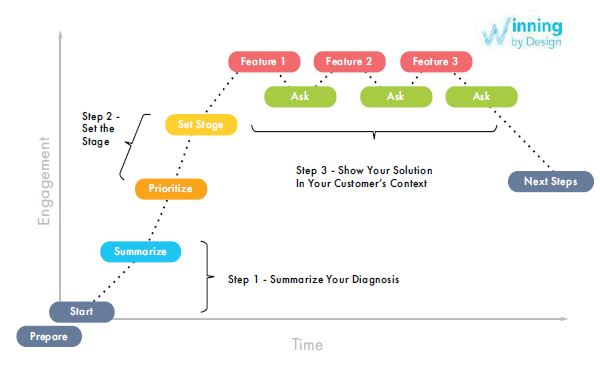Mind The Gap: Coach On How To Deliver An Amazing Demo
By Derek Sather
Ensuring that everyone on the team is consistently working on their skills, like a crafts-person or professional athlete, in their customer roles is key to working smarter.
 One of the best tools to improve as a team and enable a more structured coaching framework is to record all of your demos. This gives you the opportunity to review and analyze them in peer-to-peer coaching sessions and as a team in your weekly management cadence. To make the scoring and evaluation of demos easier, we recommend creating a demo scorecard. This helps enable peer-to-peer-based coaching so sales reps can review each other’s demo footage and provide both quantitative and qualitative feedback for improvement.
One of the best tools to improve as a team and enable a more structured coaching framework is to record all of your demos. This gives you the opportunity to review and analyze them in peer-to-peer coaching sessions and as a team in your weekly management cadence. To make the scoring and evaluation of demos easier, we recommend creating a demo scorecard. This helps enable peer-to-peer-based coaching so sales reps can review each other’s demo footage and provide both quantitative and qualitative feedback for improvement.
You need to be aware of some common mistakes to avoid and some best practices to adopt as you provide coaching on running demos.
First and foremost, people hate being “sold.” However, they love buying. Help your prospects buy through applying the knowledge you have gathered. Customize the demo and make it all about them — not about you, or how good your software is.
When coaching on running a demo, make sure that the demo is not sales-, product-, or company-centric; always make it about the prospect. Use the demo as a tool, and show the prospect your prescription to solve their diagnosis. Continue the conversation, and then go deeper into how it will impact them personally and professionally.
Unfortunately, most demos are the same and do not use any info found in the discovery call. They are prestructured and centered around features and functions with little to no correlation to the problems the prospect is trying to solve. If a presentation is used, it is often self-centered with:
- Who we are
- Our company history
- A logo slide of the great companies we work with
- The features and functions that we provide
- A Q&A slide

Once excited prospects quickly become unengaged and start reading their email or responding to the Slack message that just came in, the salesperson typically continues the monologue, and the prospect tunes out. This issue is what we call the engagement gap.
This engagement gap can be reduced significantly by connecting to the situation, pain, and impact learned in the diagnosis phase to focus the demo on the customer’s top three challenges.
Quick Tip: The best way to increase someone’s engagement is by asking an open-ended question. When your prospect answers a question, they need to spend 100 percent of their brain power, or they will sound distracted.
Here’s how to coach on structuring an amazing demo:

STEP 1: SUMMARIZE YOUR DIAGNOSIS AND PRIORITIZE THEIR PAIN
Instead of showing the 50 slides of your sales deck starting with your company history and the logo-salad of all your best customers, focus only on the three most relevant parts of your solution that will help provide the biggest impact to the prospect.
How to Coach: Do they start with the diagnosis, this is what I’m going to show you, and what it means to you and your company?

STEP 2: SET THE STAGE
Make sure your screen is clutter-free and that you turn off notifications that could distract your prospect. Orient them to what they are seeing: Give them a quick lay of the land of your user interface and what they should be looking for. If you don’t, they will be trying to absorb everything and will be distracted.
How to Coach: Do they turn off notifications, orient to the screen, and point out what part of the screen the prospect should look at?
STEP 3: SHOW YOUR SOLUTION IN YOUR CUSTOMER’S CONTEXT
Show how you solve their pain one point at a time, and share relevant use case stories of other people in the same position. Create a two-way dialogue, and ask questions for each pain point, as this will help dive deeper into the impact of your solution.
- Do you see what I showed you solves X?
- What impact would that have on your business?
- Can you see yourself (or your team) using this?
- Did the story I told resonate with you?
How to Coach: Do they address one pain point at a time? Do they ask questions after each pain point review? Did they share a relevant case story? Did they ask the prospect if story resonated with them? Did they use prospect-specific information to customize the demo?
STEP 4: NEXT STEPS
The demo is a tool to progress the conversation and delve deeper into your diagnosis. The outcome of a demo when executed well should result in the desire of the customer to receive a proposal. Be sure to summarize the key takeaways from each demo point and set the next steps in the proposal phase.
How to Coach: What new information did we learn? How will we use this to customize our proposal? Was the objective of the demo achieved? Were clear next steps confirmed and agreed to? Did we earn introductions to additional executives or team members who play an important role in the proposal evaluation process? Did they summarize each demo point?
As you coach, remember that the prospects won’t remember all the specifics of your solution, but they will remember how you made them feel when you showed them how to solve their problem.
Your team has helped other customers just like them to solve the exact same issue. Your team members are the experts. Delivering an amazing demo requires empowering your team to work smarter through peer-based coaching. You can utilize blueprints and data to scale faster through repeatable processes instead of reinventing the wheel with each customer. This will help enable a culture of working as a team, where “each one, teach one” is core to company growth. When teams and processes improve, everyone benefits.
DEREK SATHER is a partner at Winning by Design, where he specializes in helping growth-stage software firms scale from $5M to $100M ARR. He develops and delivers sales and marketing strategic plans to generate the rapid revenue growth required to hit key milestones. He is the CEO of Science to Sales (acquired by WBD) and formerly a CRO leading sales, marketing, and customer success teams.
